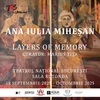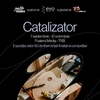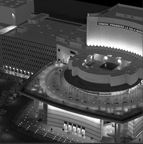Exhibitions
The Word`s Shadow Exhibition

The Word`s Shadow Exhibition and The Betrothal of Gifts
I first met Georges Banu in the “words’ shadow”, in a theatre - Theatre de la Ville, in Paris, where Lucian Pintilie was rehearsing in the 80’s. Our friendship was sealed spiritually, in time, by the means of a symbolical gift, offered intuitively, then – a drawing of mine representing an injured Jesus, which Georges spontaneously adopted. Much later, in his writings, I read his statement about the meaning and the sense of offering a gift, with which I agree: “true gifts reflect knowledge about the other, how aware we are of their desires and expectations.”
This exhibition and event is simultaneously meant as a gift in memory of Georges Banu, for everything that he has generously offered us along the way, and a gift that I am presenting likewise to all actors, theatre-makers, artists and lovers of the Arts.
The “words’ shadow” is, in fact, the trace that words leave upon reality – “the ultimate reality that remains after the theatrical act” (“About oblivion”). The shadow of the words being the ulterior projection in our memory, as well as in the visible space that contains us – the visual outcome, the material projection of our spoken words.
In the monumental hall of the Rotonda and the introductory space of the foyer, part of the National Theater, I intend to reproduce a sensitive space, to create an “installation” of Georges Banu’s living creative experience, pertaining to the visual themes that he developed and referred to, throughout his writings, based on a very subjective and affective approach, rather than a chronological one.
Georges Banu said that he found himself mirrored “in the heteroclite image of Arcimboldo’s portraits”. Thus, I am proposing, beyond deconstruction, to recompose a portrait based in his own subjectivity, taking its inception from the themes that were highlighted by Georges Banu: “The Curtain” (or the fissure of the world) as a metaphor. “In painting, as in theatre, the curtain breaks the unity. It reveals as much as it hides from one’s eye…it separates the actor from the spectator, hides the secret, while nourishing the expectation of an ever possible revelation”; “The Door”(as intimate geography), revealing the exterior as well as our interiority, its symbolic valences; “Nocturnes”, the notion of darkness and “black” in painting and theatre, the relation about shade and its projection in time, the return to light; “ The human being seen from behind”, the loneliness of man or his hidden eye, the dialectics between the expression of the back and the face, semantic ambivalences; “Wounded objects”- time’s passage upon things, the charge on their emotional value, our dialogue with the objects.
I’m inviting actors from the National Theatre, critics and theatre professionals from here or afar, who came to know Georges Banu, to intervene by spoken word and interaction with the space that has been thus created, revisiting fragments from the roles that they have already interpreted -- possibly plays and roles for which Banu had a predilection -- or pieces of his texts, encouraging every actor or participant to choose what is more representative for himself and what better defines his message.
Miruna Budisteanu

















